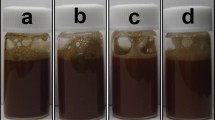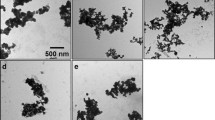Abstract
This article describes a method for preparing CuO nanoparticles in aqueous solution, and a demonstration of feasibility of metallic bonding with the use of the CuO particles. Colloid solution of CuO nanoparticles was prepared from Cu(NO3)2 aqueous solution (0.01 M) and NaOH aqueous solution (0.019 M) at 5–80 °C. Leaf-like aggregates with an average size of 567 nm composed of CuO nanoparticles were produced at 20 °C. The size of leaf-like aggregates decreased with increasing reaction temperature. Metallic copper discs could be bonded using the CuO nanoparticles under annealing at 400 °C and pressurizing at 1.2 MPa for 5 min in H2 gas. A shear strength required for separating the bonded discs was 25.4 MPa for the CuO nanoparticles prepared at 20 °C, whose aggregates were the largest among the CuO particles examined. These results indicated that the formation of leaf-like aggregates of CuO nanoparticles led to efficient metallic bonding.











Similar content being viewed by others
References
Akada Y, Tatsumi H, Yamaguchi T, Hirose A, Morita T, Ide E (2008) Interfacial bonding mechanism using silver metallo-organic nanoparticles to bulk metals and observation of sintering behavior. Mater Trans 49:1537–1545
Buffat P, Borel JP (1976) Size effect on the melting temperature of gold particles. Phys Rev A 13:2287–2298
Ide E, Angata S, Hirose A, Kobayashi KF (2005) Metal-metal bonding process using Ag metallo-organic nanoparticles. Acta Mater 53:2385–2393
Kanninen P, Johans C, Merta J, Kontturi K (2008) Influence of ligand structure on the stability and oxidation of copper nanoparticles. J Colloid Interface Sci 318:88–95
Lee SH, Her YS, Matijević E (1997) Preparation and growth mechanism of uniform colloidal copper oxide by the controlled double-jet precipitation. J Colloid Interface Sci 186:193–202
Liu Q, Liu H, Liang Y, Xu Z, Yin G (2006) Large-scale synthesis of single-crystalline CuO nanoplatelets by a hydrothermal process. Mater Res Bull 41:697–702
Matsuoka S, Imai H (2009) Direct welding of different metals used ultrasonic vibration. J Mater Process Technol 209:954–960
Moon K, Dong H, Maric R, Pothukuchi S, Hunt A, Li Y, Wong CP (2005) Thermal behavior of silver nanoparticles for low-temperature interconnect applications. J Electron Mater 34:168–175
Morita T, Ide E, Yasuda Y, Hirose A, Kobayashi K (2008a) Study of bonding technology using silver nanoparticles. Jpn J Appl Phys 47:6615–6622
Morita T, Yasuda Y, Ide E, Akada Y, Hirose A (2008b) Bonding technique using micro-scaled silver-oxide particles for in situ formation of silver nanoparticles. Mater Trans 49:2875–2880
Morita T, Yasuda Y, Ide E, Akada Y, Hirose A (2009) Direct bonding to aluminum with silver-oxide microparticles. Mater Trans 50:226–228
Murray AJ, Jaroenapibal P, Koene B, Evoy S (2006) Sintering of silver nanoparticles for the formation of high temperature interconnect joints. Mater Res Soc Symp Proc 942E:W08–W29
Park BK, Kim D, Jeong S, Moon J, Kim JS (2007) Direct writing of copper conductive patterns by ink-jet printing. Thin Solid Films 515:7706–7711
Takagi M (1954) Electron-diffraction study of liquid-solid transition of thin metal films. J Phys Soc Jpn 9:359–363
Weisman C (ed) (1976) Welding handbook, vol 1, 7th edn. American Welding Society, Miami, pp 18–19
Yasuda Y, Ide E, Morita T (2009) Low-temperature bonding using silver nanoparticles stabilized by short-chain alkylamines. Jpn J Appl Phys 48:125004
Zheng L, Liu X (2007) Solution-phase synthesis of CuO hierarchical nanosheets at near-neutral pH and near-room temperature. Mater Lett 61:2222–2226
Acknowledgments
This work was partially supported by Hitachi, Ltd. We express our thanks to Dr. T. Noguchi and Mr. M. Hayashi in College of Science of Ibaraki University, Japan for their help for TEM observation.
Author information
Authors and Affiliations
Corresponding author
Rights and permissions
About this article
Cite this article
Kobayashi, Y., Maeda, T., Watanabe, K. et al. Preparation of CuO nanoparticles by metal salt-base reaction in aqueous solution and their metallic bonding property. J Nanopart Res 13, 5365–5372 (2011). https://doi.org/10.1007/s11051-011-0522-9
Received:
Accepted:
Published:
Issue Date:
DOI: https://doi.org/10.1007/s11051-011-0522-9




